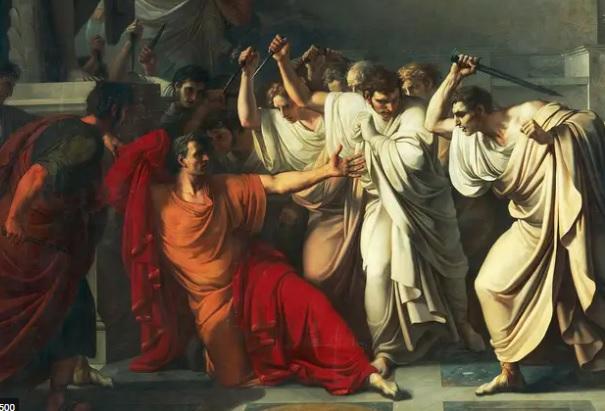The “ides” of March, or the death of Julius Caesar
The term "ides", which etymologically means "to divide" (from the Latin "iduare"), used in the Roman calendar, designates the 15th of the months of March, May, July and October, and the 13th of the other months. On March 15, in 44 BC, a festive day dedicated to the god Mars, Julius Caesar was assassinated during the meeting of the Senate in the curia of Pompey on the Champ de Mars (current forum piazza Argentina).
Chronology of the reasons for a planned assassination
The year 44 was marked by many changes undertaken by Julius Caesar, these did not please his detractors still legion in the Senate. Indeed, January 1 marks the beginning of his consulship (this is the fifth time he has held this post); he took the opportunity in particular to create in his honor a third brotherhood of Luperques. On January 26, he returned to Rome and was acclaimed king by the crowd. On February 14, during a session at the Sénart, he was declared dictator for life. The next day, during the Lupercalia celebrations, Marc Antoine publicly offered her the royal tiara. Thus, his behavior at the beginning of the year (and also before) had aroused many concerns among some senators, who decided to plot against him.
Cicero, in the Second Philippic, reports that the first plot took place in Narbonne at the end of the year 45: Caius Trebonius, former legate of Caesar during the Gallic war, explains his plan to kill him to Marc Antoine, who refuses to take part in it, but don't say a word to César. During the following months, Caesar's pride irritated the senators: after the Latin Feria, amidst collective cheers, a man stood out from the crowd to place a laurel wreath on his statue. Thus, a second plot was set up, under the direction of Caius Cassius Longinus, praetor who desired the consulship (according to Plutarch). He manages to rally several senators to his cause, he quickly understands that a symbolic personality must also integrate the plot; in fact Brutus joins the conspiracy.
@IanChisolm @Woodshed_1914 @Chuck1one @0oty_Mac @JerrelXL @DonaldP47082631 @Golfballl @SquareBidness @LooseJointny… https://t.co/RO5WhW4897
— The_Rickkler Sat Jan 11 21:47:29 +0000 2020
warning signs
According to Suetonius, several signs announced the death of Julius Caesar. A few days before his death, Caesar had received a prediction from the Etruscan haruspex Titus Vestricius Spurinna, telling him to beware of the Ides of March through the following words: "Cesare, tra lo sfarzo e la gloria, ti prega di guardarti slab Idi di marzo” (“Caesar, between pomp and glory, I warn you against the Ides of March”). But, too careless or concerned about some reforms to be carried out, he did not listen to her. Just as he saw no ominous sign in the javelin-like comet he had seen a few weeks earlier. Moreover, in Parallel Lives, Plutarch recounts that the day before his murder, Caesar dined with Marcus Lepidus. During the meal, a question was heard: "Which is the best of the dead?" “, the dictator then hastened to answer:” The one that we do not expect. On the morning of March 15, his wife Calpurnia tried in vain to prevent him from going to the Senate, having seen his death in a dream (she was crying, holding her slaughtered husband in her arms). Upon his arrival at the Senate, Artemidorus, one of Caesar's informants, tried to warn him by handing him a petition giving all the names of the conspirators, he did not deign to read it.
The facts of March 15

After imagining various scenarios, the conspirators decide to act during the session of the Senate on the Ides of March. Thus, on March 15, after luring Marc Antony out of the curia of Pompey, the conspirators stabbed Caesar 23 times, who wrote, according to Suetonius: “Ista quidem vis est! ("But it's violence!"). It would seem that when Brutus draws his dagger, Caesar uttered the words “Tu quoque mi fili” (“You too my son!”). At the end of the day, slaves come to collect the body to take it to the doctor Antistius, according to whom only one of the twenty-three stab wounds would have been fatal.
The exact location of the murder
In 2012, CSIC researchers, led by historian Antonio Monterroso, found during excavations in the piazza Argentina forum a concrete slab three meters wide and two meters high. This one, commissioned by Octave (Auguste), in memory of his adoptive father, would have been placed precisely at this location to indicate the place of the murder.
A place of commemoration
Usually, Rome celebrates these ides in a grandiloquent way, following the example of the myths of the past, as if to revive the origins of the city. Indeed, last year, the Gruppo Storico Romano had reconstituted the death of Julius Caesar in the forum of Largo Argentina. One could admire the arrival of Caesar, the conspirators facing him within the curia of Pompey; Then followed twenty-three stabs, after which a long procession went to the Tempio del Divo Giulio in the Roman Forum. Unfortunately, this year, due to the imposed quarantine, this re-enactment could not take place. The Gruppo Storico Romano apologizes to all those who wished to attend this event and to the accredited newspapers and radio stations. But as the Romans said: UBI MAIOR MINOR CESSAT! We can nevertheless see this event again in this video from 2016 or watch an extract from the film César (2012) and the series Rome








